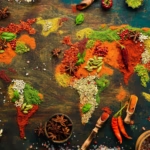Food does more for the body than just keep it going. It’s a big part of health, a part of society, and a way to connect with other people. When we eat, it changes many things about our lives. Food shows who we are and where we come from, from old recipes that have been passed down through generations to new food trends. This book will teach you the basics of nutrition, give you a taste of food from around the world, and cover the newest food trends and inventions. Get ready to change the way you think about food.
Contents
What you need to know about nutrition and eating well
The Basics of Nutrients That Are Important for Health
To work well, your body needs different building blocks. The name for these is nutrients. Among them are:
Macronutrients are fats, proteins, and carbohydrates. These give you energy and help your plants grow.
The vitamins and minerals that are micronutrients. Their job is to keep your body healthy, your immune system strong, and your bones strong.
Following the advice of the USDA or WHO on how to eat a varied diet can help you stay healthy. These rules help us figure out how much of each nutrient we need and urge us to eat a wide range of foods.
How to Put Together a Healthy Meal
It doesn’t have to be hard to plan meals that are both tasty and good for you. These are some easy tips:
Fruits, veggies, grains, protein, and dairy are just a few of the food groups that you should eat.
Moderation is key when it comes to food amounts.
Pay attention to your body’s signals when you’re hungry or full.
Superfoods, such as blueberries, kale, or nuts, can be added to boost the taste and nutrition.
Making small changes to the way you eat can often lead to better health and better eating habits in general.
What You Eat Can Affect Your Long-Term Health
What we eat affects how quickly we age and our chance of getting long-term diseases like diabetes and heart disease. A healthy diet can help keep these problems away and make you live longer. Experts say that eating well isn’t just something you should do today; it’s something you should do for the rest of your life.
Cuisines from around the world and cultural food traditions
A Look at the World’s Most Popular Cuisines
There are different ways to cook food in each part of the world. Here are some examples:
People know Asian food for its rice, noodles, and strong tastes like ginger and soy.
The Mediterranean diet is based on seafood, fresh veggies, and olive oil.
Latin American food is hot and includes corn, beans, and tropical fruits.
Middle Eastern food, like hummus and kebabs, is full of veggies and spices.
Every type of food has a past that affects the ingredients and ways of cooking it. These dishes tell tales of trade, travel, and family history.
Food as a part of cultural identity and tradition
Food is an important part of national identity. Rituals, holidays, and family get-togethers all use it in some way. Traditions live on because many recipes are passed down from one family to the next. Japanese tea rituals are about more than just tea. They’re also about harmony and respect. In Italy, pasta stands for society and family.
Modern fusion and new ideas in cooking
Chefs today are mixing tastes from around the world to make new and interesting meals. These are like sushi sandwiches or Korean tacos—the best of both worlds. It’s easy to find and try new tastes thanks to globalization. This mix of foods makes things interesting, fun, and relevant to our world’s many cultures.
Food Industry Trends and How People Eat
The Growth of Plant-Based and Other Proteins
More people are picking plant-based foods. It’s a huge market for plant-based foods and dairy alternatives. New research shows that these choices may be better for your health and the world. Now you can find a lot of vegan foods in stores, like veggie burgers, almond milk, and cheeses. These foods are good for you and the environment if you eat them.
New technologies and foods
We are shopping and cooking in new ways thanks to apps and tools. It’s easier to make healthy meals with food delivery services, meal kits, and smart kitchen tools. Lab-grown meats and personalized meals based on DNA are the newest and most cutting edge ideas. These new ideas could change what and how we eat in the future.
Eco-Friendly and Moral Eating
Food made with care for the world is something that more people want. Food waste reduction and sustainable sources are big issues right now. To find out how your food was made, look for marks like “Organic,” “Fair Trade,” or “MSC.” Making small changes, like throwing away less food, composting, and buying eco-friendly goods, can make a big difference.
What Food Can Do for Your Health and Mindfulness
Link Between Food and Mental Health
Gut health affects more than just nutrition; it also impacts how you feel. Seafood and nuts, which are high in omega-3s, are good for your brain. Eating dark chocolate and yogurt with a lot of probiotics has also been linked to feeling better. Mindfully eating keeps us from overeating and lets us enjoy our food more.
Eating habits that are good for you
Being with loved ones over a meal can help you relax and improve your bonds. Making eating habits, like having breakfast together every day, gives you comfort and security. Emotional health can also be improved by using food as a form of self-care, like making healthy meals or having a warm cup of tea.
Supplements and foods that are good for you
People think that some foods and herbs are good for your health. Think about acai berries or plant teas as examples of superfoods. They may be good for you, but it’s best to eat them as part of a healthy diet. Supplements shouldn’t be used instead of good food.
Food knowledge is more than just what’s on your plate. It’s about learning about different countries, knowing what nutrients your body needs, and keeping up with the latest food trends. By making choices that are good for you, culturally appropriate, and good for the environment, you can enjoy food more and be healthier overall. Enjoy the many tastes that our world has to offer as you keep learning and trying new things.
FAQs
What are the main macronutrients I should eat?
Macronutrients include fats, proteins, and carbohydrates, which provide energy and help your body grow.
How does food affect mental health?
Certain foods like seafood, nuts, and probiotics can boost brain function and improve mood.
What are some eco-friendly eating practices?
Buying organic, fair trade products, reducing food waste, and composting are effective ways to eat sustainably.





